When Climbers go bushwalking - Rock climbing Federation peak
By Gaetan on Tuesday ,13 May 2014, 22:16 - climbing - Permalink
SEAN AND I always had similar interest in climbing, big long multipitches. So when he suggested that we had a go at climbing the north west face of Federation Peak, I almost instantly agreed. Federation peak is the highest peak in the Arthur ranges in the wilderness area of south west Tasmania. There isn't any easy access, and it requires some serious bushwalking to get to there. MUMC missed out on the first ascent, which fell to John Bechervaise in summer 1949. MUMC spent 45 days up there a few years later, supported by air food drop. They did some exploration and added a number of route on the peak. Six new one that they named , MUMC route nb 1 to MUMC route nb 6, they weren't very inventive at the time. MUMC route nb 2 is the one used by bushwalker,called the normal route nowadays. Given the adventurous nature of the project and the obvious relation with MUMC history we decided to apply for MUMC Adventure Grant 2012, which we were granted. The project was on! Our initial plan was to climb the north west face, and maybe, time and weather permitting, repeat a couple of the MUMC route.
After a bit of research we found out that we needed two days to get to the Berchevaise plateau and about the same time to get out. So, we decided to recruit a couple of porters to help us carry the food and the gear. We only managed to convince Tanya Craig, although convince is a big word, she happily joined the team. A good pick as she is a Tassie bushwalk veteran, master in navigation and a good weather lucky charm.
Early February, Sean and I crossed the sea over to Tasmania and made our way down to Hobart. There, we busied our self, finishing the trip preparation. The next day we picked up Tanya flying back from south america. We agreed to leave as soon as possible, there was a five days weather window forecasted. Luck was on our side. After a day of packing and buying the last items, we drove into the wilderness to camp at the start of the track. We were going in from Farmhouse creek, the quickest way to get to Federation peak.
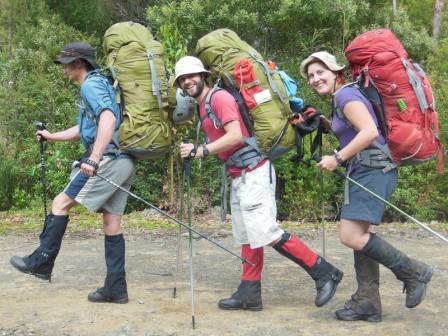
The team ready to go, Sean , Gaetan and Tanya (no we are not sponsored by Osprey)
Sean and I used beta from climbers to plan the trip, but upon closer look at “the Book of Chapman”[1], we realised we had to do three Chapman days in two, with pack weighing more than 25kg. That was going to be interesting. On the first day, we started motivated and in good spirit, however around midday we got a bit lost. At the top of the main spur for the track gets a bit confusing, it branches of the old track to follow the new access. We learned later that everyone tend to get lost there, hence the false lead that confused us. While we were looking for the correct way we managed to start backtracking thinking we found the correct track. We only realised that after a bit more that thirty minutes and lost about three hours that day, not a good start. We made it to the first camp at dusk without further issues. But it became quite clear that we weren't going to make it to the plateau in two days.
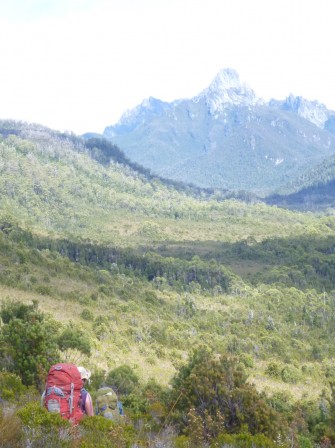
First view of Federation peak
On day two, we carried on, the going was a bit a slow in the Forested area, having to go over and under roots and fallen tree. Little did we know that the worse was yet to come. Once out of the forest, we got our first view of Feder, still a long way away. Although that was good for the motivation, the bit of rock brighten Sean's mood. We didn't quite get to the camp we wanted to that day, but still seemed to be on track for our revised 3 days walk in. Sean and I were feeling the kilos, after all we are “off the couch” bushwalker, motivation did get a bit low that evening. Sean was almost ready to ditch the climbing gear ! Fortunately, some food and a good night sleep got us back on our feet. On day three, we had to go up the infamous moss ridge, a steep section where you can't really stop for the night, so you have do it in one go. It lived up to its reputation, we were scrambling on roots, crawling over and under trees. I am not sure you can really call that bushwalking, definitely bush but it didn't feel like walking. There is a bivouac site on the ridge, where there is enough space to pitch a tent but the muddy ground is not appealing. The first high point of the ridge is a bit deceptive, it offers a nice view of the peak, we were getting closer. But we could also see a couple of pinnacle we had still to overcome. We pushed on, climbing a few exposed steps, skirting around the pinnacles and we finally made it to the berchevaise plateau. The lower part of the plateau is currently closed , to allow the vegetation to recover. It's quite a popular place to camp. To mitigate the erosion problem, a couple of wooden platform have been installed. That's where we set up our base camp.
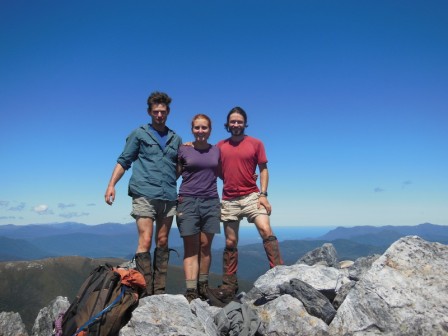
The team on top, with beautiful weather and awesome views
Taking advantage of the still good weather, we decided to go to the top of Federation peak on day four. But first, we had a lazy morning allowing us to recover a bit from our effort from the past three days. We went to the summit via the normal route, a grade 5-ish scramble on very exposed terrain. From the plateau, we walked up to the base of rock part of Feder. There, a cleft (Geeves Window) allowed us to go down and on the back of the peak. That is also the track to follow if you are doing the Arthur's traverse. At the back you get to really appreciate the exposure, one can see lake geeves sitting 600 meters below ! Once at the back, we veered off the track to climb up the obvious gully, the giant chockstone is an unmistakable landmark. We carried on weaving through the face taking the path of least resistance. They are a few technical steps but nothing difficult. Tanya managed it all nicely, we didn't have to use the rope. We got to the top in beautiful weather, allowing us to admire the view. We took the obligatory summit photo, and wrote an entry in the logbook. Enjoying our position, we laze about a bit the view of the rest of the Arthur's ranges was beautiful. We got down the same way, that was a bit more stressful, as “down climbing” is always a bit more difficult. But once again Tanya managed it without the use of a rope. Great time to be out there. In the evening, we enjoyed one of our delicious dehydrated meals, and discussed climbing plan.
While preparing the trip, Sean and I didn't realise that we wouldn't be able to see the north west face from where we were. That means no way to scope the route, which we were planning to do before starting on the route. It's really committing, as to access the base, an abseil is required. And if one has to bailed, it would require an epic bush bash to get back to camp. In the end, we agreed to try the golden diedre. A beautiful golden corner that's about the same difficulty as the north west face (grade 17) but definitely less committing.
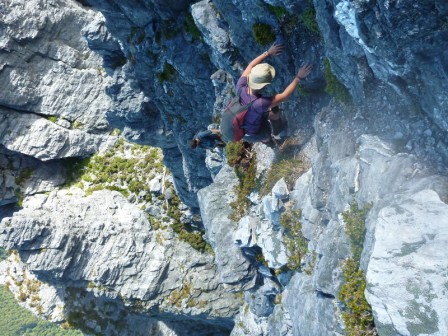
Sean and Tanya on the scramble down, to give an idea of the exposure there is 600m drop below
On day 5, early morning this time, Sean and I left camp with ropes and climbing hardware. First tasks, checking out the climbers gully. It's a grade 12 climb that provides the quickest way to the top, and the way Berchevaise took. We quickly dispatched the climbing and got to the pile of slings that serves as abseil anchor. From there we dropped down to a gully that allows direct access to the top. The gully is a bit scary as it's full of loose rock, one as to take care when climbing it. We started by that, as it was going to be our descent route, way quicker than walking around like we did the previous day. Back on the ground after climbing up and down the gully and a quick abseil, we were now looking at our next objective, the Golden Diedre. Sean quickly ran up the first pitch and brought me to a questionable anchor, not much gear available there. I took over the lead, and scrambled up easily to reach the corner. I got some good gear in, as I expected, but going higher up there wasn't much gear available in the corner. Instead, I resorted to sling a bush, before having a look at the small bulge now in my way. As I went up I still couldn't find any gear, the moves looked fine, but I was not thrilled by having a bush as my last runner. I didn't really want to have to down climb the bulge, if wasn't able to find more gear above. After a chat with Sean, we decided to bail and move onto the north east corner, the next corner system on the face. Not as nice looking as the golden diedre but easier as it's supposed to be a grade 14.
Back to my nicely slung bush, I down climbed to the last good gear, and started traversing across. Some interesting climbing there, I had to cross some vegetation, not the most secure climbing. Some call it dirtaineering. At least the belay stance was really nice. Sean got to work and tackled the nice corner and ran a rope stretching pitch. He used all our gear and had to resort to some old trick to get more protection in. The highlight of that pitch was Sean going over a small tree that he used for protection. Seconding the pitch, I had to squeeze between the tree and the corner, that proved quite tricky as I was carrying the pack. Anyway I made it to the anchor without too much complain. We got Sean in a comfy position, and I set off for the next pitch. The climbing was interesting and sustained. It's mostly slab climbing on the face, with some move bridging the corner in between slab section.The rock is quite good but the protection was a bit sparse. I got to a nice ledge when reaching the end of the ropes, perfect. Sean got the last pitch, it started with a few technical moves, before turning into an easy scramble to the top. Once I reached him, I scrambled up to check out where the descend was. Unfortunately, the bit of rock I was on was not connected to the main part and I had to do some scary down climbing to get back and around to our descend route. Once again we went down the climber's gully. What' a great day ! Almost like cragging at Arapiles, also I must say going up and down the climbers gully was quite taxing mentally. Tanya enjoyed a rest day, and took some pictures of us on the face, which you get to enjoy.
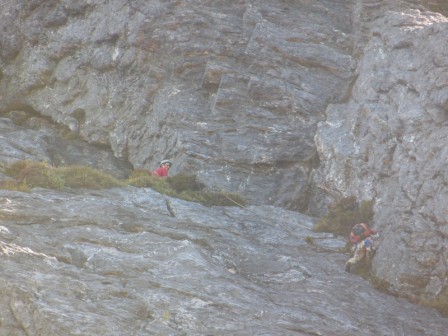
Sean belaying Gaetan on pitch three (photo by Tanya Craig)
Day 6, It's now time to leave this beautiful place. Surprisingly the weather was still good, looks like our weather charm was working. Moss ridge was again hard work to get down, it's more like scrambling really. But once on flat ground we picked up the pace a bit. It was nice to be carrying less gear. Surprisingly we made it to Forest camp, which means we did one and half day compared to our pace on the way in. It also happened to be my 31th birthday, not bad for an old man.
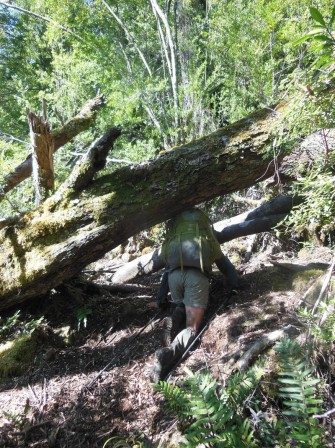
A small glimpse of the easy track ...
On day 7, we met 2 bushwalkers, the first and only people we met during that trip. That day proved to be quite taxing, as we were trying to get out in one last push. Toward the end of the day, everyone had sore feet, and the pace wasn't that quick. We got to the last camping spot at dawn, which we though was only half an hour away from the car. We still stopped there for the night, as I think we were in too much pain to carry on, at least I was. It rained a bit during the night, at last we got a small taste of the infamous tassie weather. On the last day, we got a lazy start we had no need to rush. We put our wet weather gear, although it wasn't raining much when we left, I think it was mostly to say we didn't carry it for nothing. It took us about an hour to get back to the car and we were going at a good pace. That was a good thing that we stopped for the night the day before. We drove back to Hobart in a gloomy weather, and enjoyed some well deserved rest.
By Gaetan Riou
Photograph by Gaetan Riou unless mentioned otherwise
Route description : North East corner accessed from golden Diedre (~140m grade 14)
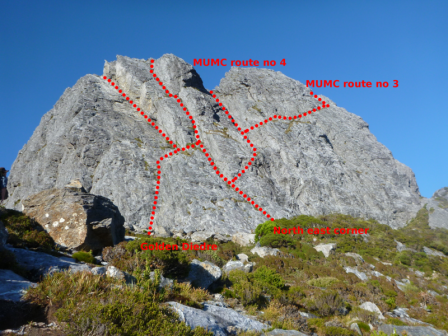
- 30-35m : As for golden Diedre. Go up the obvious weakness, going right-ish. Belay at the bottom of a sloping ledge.
- 20-25m : Scramble up to ledge at to reach bottom of golden Deirdre corner. (Good gear) Traverse across through bush to a good belay ledge. Gear in the left hand crack
- 40m : Up corner, pass a big ledge after 10m. Carry on mostly on the face, pass a tree runner to small stance. Crack take a #4 camalot.
- 40m : Up on the face, sometimes following feature on the left. Climb around vegetation to reach big belay ledge. Good gear in the corner.
- 15m : Exit ledge on the right, then easy scramble to big sloppy ledge. Belay from boulder.
Scramble right and through the obvious weakness to reach the descent gully.
Rack
- 10 alpine runners
- 2 set of nuts
- 7 cams (#.5 to #4 camalots, small size not useful)
- 50m half ropes (enough to abseil down climbers gully in one go)
- a few double length slings
This article was first published in The Mountaineer, Summer 2013 - 24. The mountaineer is the Melbourne Uni Mountaineering Club magazine. For more information about the club, check the website : www.mumc.org.au
Note
[1] South west tasmania by John Chapman